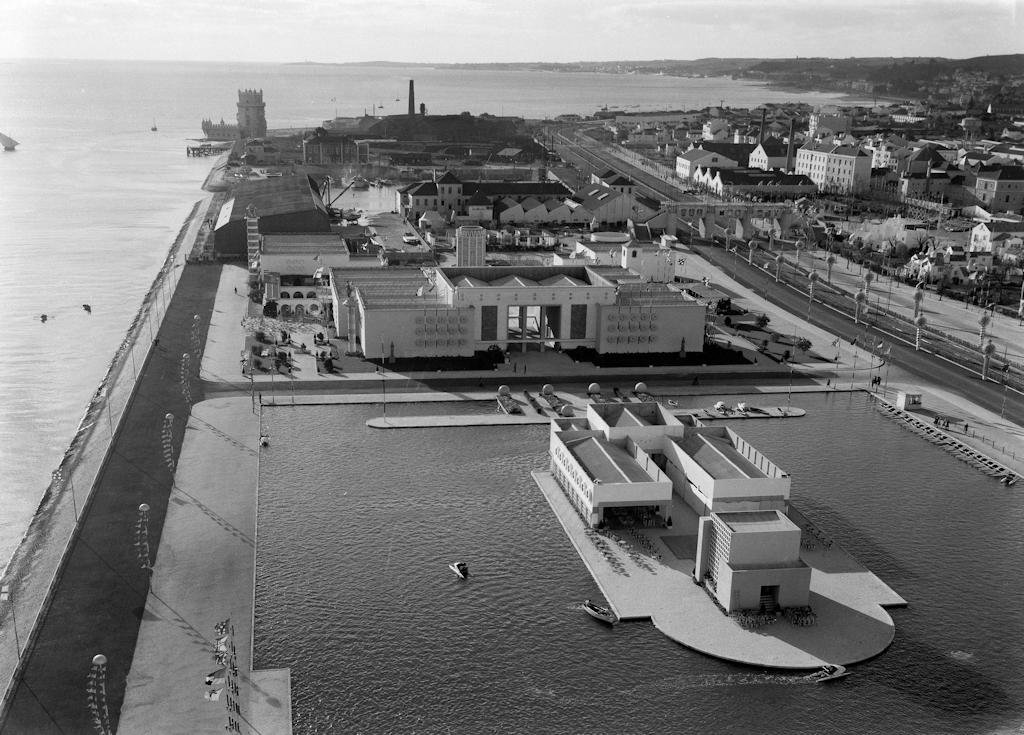The regime understood the importance of these celebrations in publicly establishing its own ideological and historical legitimacy. The State sought to associate the defining traits of its nationalism — authoritarianism, elitism, paternalism, and conservatism, with a mythical and legitimizing past. This effort to combine art and politics was spearheaded by António Ferro, the daring director of the Secretariat for National Propaganda. The exhibition represented a successful fusion of art and politics within the Estado Novo regime.
The national commission responsible for organizing the exhibition was chaired by Alberto de Oliveira and supported by a wide range of public figures. The executive committee was led by Júlio Dantas, with António Ferro as the secretary-general. The special committee was directed by Augusto de Castro, assisted by Sá e Melo, and the chief architect was Cottinelli Telmo. Gustavo de Matos Sequeira coordinated the historical aspects, José Leitão de Barros oversaw external services, and Gomes de Amorim was in charge of landscaping. The exhibition included thematic pavilions showcasing Portugal's history, economic activities, culture, regions, and overseas territories. The only foreign country with a pavilion was Brazil, reflecting the close ties between Portugal and its former colony.
The exhibition was situated in the western part of Lisbon, between the right bank of the The Tagus River (Rio Tejo) and the Jerónimos Monastery (Mosteiro dos Jerónimos). It covered an area of approximately 560,000 square meters and involved extensive urban renewal in the surrounding area. The location was carefully chosen to create a dramatic and theatrical effect. The exhibition featured a monumental Plaza of the Empire (now Praça do Império Garden), flanked on one side by the Pavilion of Honor and Lisbon (designed by Luís Cristino da Silva) and on the other side by the Pavilion of the Portuguese in the World (designed by Cottinelli Telmo).
The main entrance was located in Praça Afonso de Albuquerque, near the Jerónimos Monastery. Two additional entrances were situated on either side of the railway line, marked by four square buildings adorned with low reliefs depicting medieval warriors with large shields. Visitors crossed the railway line via a grand walkway, leading them to the Historical Section, which included the Pavilhão da Formação e Conquista, Pavilhão da Independência, Pavilhão dos Descobrimentos, and the Esfera dos Descobrimentos. On the other side, there were the Pavilion of Foundation, the Pavilion of Brazil (as the guest country), and the Pavilion of Colonization. Moving through the Commercial and Industrial District, visitors approached the Colonial Section. In the opposite corner, there was an Amusement Park that delighted the younger visitors. Descending towards the Tagus River, beyond the Pavilion of the Portuguese in the World, was the Metropolitan Ethnography Section, featuring a Regional Center representing Portuguese villages and Pavilions of Popular Art. Behind the latter pavilion, there were the Jardim dos Poetas (Garden of Poets) and the Children's Park. Facing the Tagus River, with its docks, an Water Mirror with a restaurant led the way to the The Discoveries Monument (Padrão dos Descobrimentos) and the Nau Portugal.
The exhibition featured several remarkable architectural works. The Pavilion of Honor and Lisbon received accolades from critics and is considered one of the best buildings of the exhibition. With a length of 150 meters and a height of 19 meters, it boasted an imposing tower reaching 50 meters high. This pavilion embodied the historicist and revivalist architectural ideals that the Estado Novo regime sought to promote, in line with other European totalitarian regimes of that time. The Pavilion of the Portuguese in the World, designed with simpler lines, featured the imposing statue of Soberania (Sovereignty) by Leopoldo de Almeida. This statue depicted a stern armored woman holding an armillary sphere, leaning on a coastline labeled with the different parts of the world in Gothic lettering.
Lisbon.vip Recommends
One of the highlights of the exhibition was the Nau Portugal, a faithful replica of a 17th-century galleon from the India Run. The project was spearheaded by Leitão de Barros, Martins Barata, and Quirino da Fonseca. The Nau Portugal was built in the shipyards of Aveiro and initially capsized just minutes after its departure. It was then painstakingly brought back to its upright position and later piloted to Lisbon by English sailors under the command of Captain Spencer.
The exhibition also showcased the work of numerous painters and sculptors. A total of 43 painters participated, including members of the team responsible for Portugal's pavilions at international fairs in Paris, New York, and San Francisco. Renowned artists such as Almada Negreiros, Jorge Barradas, Lino António, Martins Barata, Manuel Lapa, Sarah Afonso, and Estrela Faria were among the participants. In terms of sculpture, 24 sculptors contributed their works, with notable artists such as Canto da Maia and Leopoldo de Almeida creating remarkable pieces. The exhibition also featured the Nau Portugal, a reconstruction by Leitão de Barros, Martins Barata, and Quirino da FonsecaMeta Description: Explore the historical significance of the Portuguese World Exhibition (Exposição do Mundo Português) in Lisbon, a grand event held during the Estado Novo regime.



